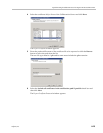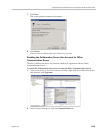
Appendix H-Setting the Collaboration Server for Integration Into Microsoft Environment
Polycom, Inc. H-35
Collaboration Server Integration into the Microsoft Lync
Server 2010 and Lync Server 2013 Environments
From Version 7.8, the The RMX interoperability level with Lync 2013 is identical to Lync
2010. Lync 2013 is backward compatible with all RMX Lync 2010 features.
From Version 7.1, Collaboration Server systems can be integrated into the Microsoft Lync
Server 2010 (Wave 14) environment.
In the Lync Server 2010 environment, only the Matched URI dialing (using the SIP URI
address) is available as the call routing method.
Configuring the Polycom-Microsoft Solution
See the Polycom Unified Communications Deployment Guide for Microsoft Environments,
“Deployment Process for Polycom Collaboration Server Systems” for detailed steps on how to
deploy a Polycom Collaboration Server system for use with the video conferencing solution
in Microsoft Lync Server 2010 environment.
Call Admission Control (CAC)
Microsoft Call Admission Control (CAC), a protocol that enables bandwidth management
via the Policy Server in federated (ICE) environment, is supported on the Collaboration
Server.
The Policy server functionality enables the Lync server to manage the bandwidth allocated
to the Lync client when connecting to another Lync client or a video conference running on
the Collaboration Server. The bandwidth allocated by the Policy server may be the same or
lower than the bandwidth requested by the Lync client, which is based on the line rate of the
conference.
Guidelines
• Microsoft CAC is available only with:
— A Lync server (Wave 14)
— Call Policy functionality enabled
— The Call Admission Control enabled for the Lync Clients
— ICE environment
— Local network
— Collaboration Server MPM+ and MPMx Card Configuration Modes
• Microsoft CAC is applicable only to dial-in calls
• Additional configuration on the Microsoft side is not required. It is based on the
existing ICE environment configuration.
• Additional configuration (setting a system flag) may be required on the Collaboration
Server to modify the system behavior when CAC is enabled in a local network; closing
the ICE channel or keeping it open.
Non-Lync endpoints connected to the same CP AVC-based conference as Lync endpoints running
on the Collaboration Server, cannot participate in the desktop sharing session initiated by Lync
participants.


















